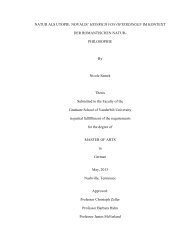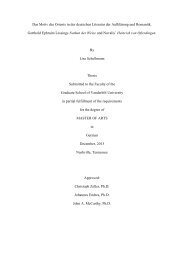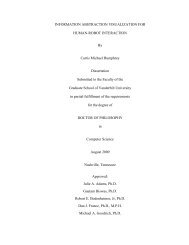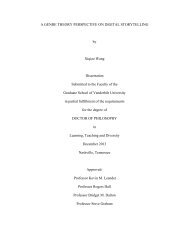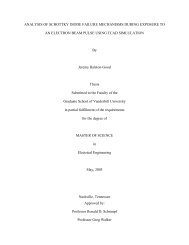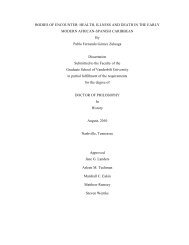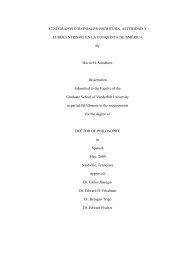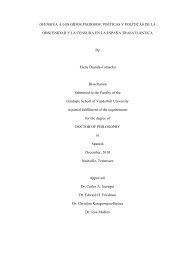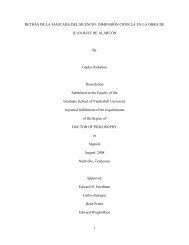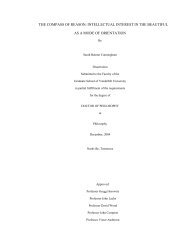EVIDENCE OF ACCRETION-GENERATED X-RAYS IN THE YOUNG ...
EVIDENCE OF ACCRETION-GENERATED X-RAYS IN THE YOUNG ...
EVIDENCE OF ACCRETION-GENERATED X-RAYS IN THE YOUNG ...
Create successful ePaper yourself
Turn your PDF publications into a flip-book with our unique Google optimized e-Paper software.
6<br />
Fig. 2.— X-ray to bolometric luminosity ratio plotted against rotation period (left panel) and the Rossby number, Ro = Prot/ (right<br />
panel), for all stars in our sample with X-ray luminosities and photometric rotation periods. Stars known to be binaries are shown as plus<br />
symbols, and the Sun is indicated with a solar symbol. The best-fitting saturated and non-saturated activity–rotation relations described<br />
in the text are shown as a dashed red line in the right-hand panel.<br />
Figure 7: Figure 2 adapted from Wright et al. (2011) displaying X-ray to bolometric<br />
luminosity ratio (RX) plotted against rotation period (Prot)(left panel) and the Rossby<br />
number (Ro)(right panel) for all stars in the Wright 3.1.1. Probing et al. the(2011) dynamo e sample ciency with with an X-ray X-ray<br />
unbiased sample<br />
luminosities and photometric rotation periods. Stars known to be binaries are shown<br />
as plus symbols, and the Sun is indicated with a solar symbol. These data show that<br />
(RX) increases with decreasing (Prot) anddecreasing(Ro) up to a limit, at which<br />
point (RX) saturates.Thebest-fittingsaturatedandnon-saturatedactivity-rotation<br />
relations are shown as a dashed red line in the right-hand panel.<br />
log C+ log Ro to all stars with Ro 0.2 using the di↵erent<br />
types of linear regression fits in Isobe et al. (1990).<br />
We find a good agreement between the slopes derived<br />
from these di↵erent fits, suggesting that the fits are all<br />
fairly linear in the log RX – log Ro plane. We favor<br />
the Ordinary Least Squares (OLS) bisector since the<br />
objective of the fit is to estimate the underlying functional<br />
relation between the variables, as recommended<br />
by Isobe et al. (1990), and this method also factors in the<br />
scatter of the line in both variables. The fit gives a slope<br />
of = 2.55 ± 0.15 (valid in the range 0.2 6.3), significantly steeper<br />
than both the canonical value and that found from our<br />
two-part fit. Mamajek & Hillenbrand (2008) fit a loglinear<br />
function to the RX Ro distribution, with the<br />
goal of empirically deriving a correlation that would allow<br />
age estimates to be derived from X-ray luminosities<br />
(via rotation periods). Their fit does not connect with<br />
the level of saturated X-ray emission for very fast rotators<br />
but, as they note, it o↵ers a good fit to many of the<br />
slow rotators such as the Sun.<br />
The sample used here su↵ers from a number of biases<br />
due to the selection of only sources with measured Xray<br />
fluxes and photometric rotation periods. While the<br />
biases stemming from the detectability of rotation periods<br />
are myriad and complex, the luminosity bias induced<br />
by only using sources with measured X-ray fluxes<br />
is clear. This bias will be most prominent in the unsaturated<br />
regime where X-ray luminosity ratios may reach<br />
as low as ⇠ 10 7 dependent on the rotation of the star.<br />
or lower. This sample could therefore<br />
be missing some of the faintest sources at a given<br />
Rossby number, possibly resulting in a larger spread in<br />
the RX Ro diagram than is currently observed. Such<br />
a spread could easily be induced by the increased amplitude<br />
of stellar coronal cycles that has been suggested<br />
to occur as stars age (e.g. Micela & Marino 2003). At<br />
the largest Rossby numbers it is likely that many of the<br />
faintest X-ray sources are not detected, inducing a strong<br />
bias in our sample that will a↵ect the fits derived here.<br />
To overcome the biases in our large sample we have<br />
attempted to compile from within our sample a smaller,<br />
X-ray unbiased sample that covers a large range in Xray<br />
luminosity ratios and rotation periods. For this we<br />
use the list of 36 Mt. Wilson stars with rotation periods<br />
from the study by Donahue et al. (1996), all of which<br />
were detected by ROSAT and therefore do not su↵er<br />
from X-ray luminosity biases. These 36 stars are the<br />
subsample of their entire sample of 100 observed stars<br />
with measurable rotation periods over five or more seasons.<br />
The authors discuss a number of possible biases in<br />
their sample resulting from e↵ects such as active region<br />
growth and decay, multiple active regions, and latitudinal<br />
bands. They conclude that the resulting biases a↵ect<br />
only P , not the period itself, and are either small or act<br />
to reduce the measured value of P . Therefore we believe<br />
that this sample of 36 stars with measured rotation<br />
periods and and X-ray luminosities is free from the majority<br />
of biases. These stars were included in our sample<br />
as part of the compilations of Pizzolato et al. (2003) and<br />
Mamajek & Hillenbrand (2008), and in Figure 3 we show<br />
their distribution in the RX–Ro diagram, all of which fall<br />
in the unsaturated regime of coronal emission.<br />
We fitted a simple single-part power law of the form<br />
log RX = log C + log Ro to these points, using an OLS<br />
bisector (Isobe et al. 1990), though the slopes derived<br />
from all the di↵erent fitting methods are in good agreement.<br />
The fit gives a slope of = 2.70 ± 0.13 (valid in<br />
the range 0.3 6.3),<br />
steeper than that found from our larger sample, in agreement<br />
with our predictions of the uncertainties induced by<br />
the biases of that sample. This slope is even steeper than<br />
the canonical value of = 2 as well as the slope found<br />
by Pallavicini et al. (1981) of = 1.9 ± 0.5, though<br />
their use of projected rotational velocities instead of rotation<br />
periods represents a di↵erent relationship than<br />
that fitted here. However this slope is in good agreement<br />
with Güdel et al. (1997) who derive a similar slope,<br />
boundary between the radiative and convective zone which can generate a magnetic<br />
field. T Tauri stars, on the other hand, are fully convective, and thus are unable to<br />
create an ↵!-dynamo. As a result, theorists now believe that fully convective stars<br />
are able to generate magnetic fields via a “turbulent” dynamo that is only weakly<br />
Flaccomio et al. (2005) reanalyzed the results of Chandra Orion UltraDeep Project<br />
(COUP), a 2003 survey consisting of an 850 ks Chandra observation of the Orion<br />
Nebula Cluster (ONC). Flaccomio et al. (2005) specifically searched for clues as to<br />
how X-ray emission of ONC stars is related, if at all, to rotation. Restricting their<br />
analysis to stars with known rotation periods as well as using both unfiltered and<br />
27



